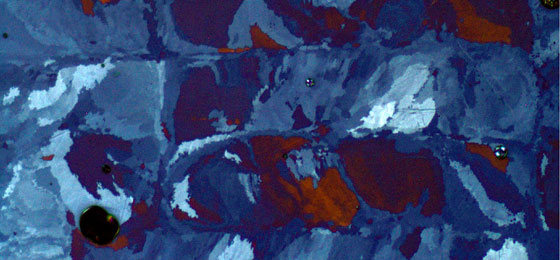Smart materials, smart researchers

Twenty-three industrial collaborations, twelve patents and two start-ups: the National Research Programme “Smart Materials” (NRP 62) has succeeded in encouraging an entrepreneurial spirit among scientists active in basic research.
For the first time, the Swiss National Science Foundation (SNSF) officially collaborated in a research programme with the Commission for Technology and Innovation (CTI) to encourage researchers to take their discoveries out of their labs and develop concrete applications. The lessons learned during the last five years will help in planning new types of collaboration between the two institutions. The goal is to accelerate the transfer of scientific results into practical applications that are sufficiently advanced to awaken the interest of various industries.
Many medical applications
The 21 projects of the programme fabricated – and used – new types of smart materials, new kinds of responsive materials that can change their properties when exposed to different stimuli. For instance, they become porous when heated, change shape when illuminated or twist like a spiral when immersed in water.
A number of projects looked at potential engineering applications, ranging from energy-harvesting devices to radically new types of electronics (see “Project highlights”).
The majority of the proposals submitted by the researchers deal with medical applications, in particular targeted drug delivery, where therapeutic molecules are precisely unloaded where and when desired, with the benefit of greatly reducing the required doses and thereby the side effects. Other researchers invented new medical devices, such as a sugar sensor for premature babies or elastic scaffolds for bone regrowth.
“We were surprised to see so many good medtech project applications,” says Louis Schlapbach, President of the Steering Committee of NRP 62. “Smart materials have a lot of potential in various disciplines. Fascination in science originates in the fact that you can never predict what you’ll find. In retrospect, our experience has shown that both medtech SMEs and larger companies are very open to original approaches coming from basic research.”
A recipe for innovation
NRP 62 was the first official collaboration programme of the SNSF with the CTI aimed at boosting technology transfer. “The idea was to create the right environment to inspire researchers to think from the start about possible applications,” says Louis Schlapbach.
CTI experts, who maintain close links to the industry, were included in the Steering Committee of the programme. Training and networking events helped young researchers to consider the practical potential of their discoveries and familiarised them with entrepreneurship issues, such as intellectual property and launching start-ups.
In the middle of the five-year programme, the Committee selected eleven projects for further funding (from the original 21) that had made good progress both scientifically and in developing industry contacts. At least seven projects will continue after the closure of NRP 62 as CTI projects.
“The focus on knowledge and technology transfer within NRP 62 was very profitable for the young researchers in my team,” says Dominique Pioletti from EPFL, who developed a targeted drug delivery system for damaged knee cartilage. “To transform my research into something directly useful is what drives me in science,” adds Martin Wolf from University Hospital Zurich, the inventor of a portable glucose sensor for premature babies. “Helping others can be an incredible motivation.”
Based on the experience gained from NRP 62, the SNSF and the CTI are jointly developing new instruments to boost innovation in Switzerland by filling the gap between basic research and prototypes.
National Research Programme “Smart Materials”
NRP 62 was launched in 2010 with a budget of CHF 11 million to support research in smart materials. This new generation of materials can modify their properties (such as mechanical, thermal, electrical or magnetic) when exposed to different stimuli. Their responsiveness could give rise to applications in many domains, from medicine to electronic sensors and energy efficiency.
A second goal of the programme was to encourage technology transfer from basic science into prototypes advanced enough for industrial or medical application. It is the first National Research Programme, an instrument of the Swiss National Science Foundation, to be conducted in collaboration with the Commission for Technology and Innovation.
NRP 62 in numbers:
– 174 scientific publications
– 79 PhD students and postdocs
– 73 industrial contacts
– 23 industrial collaborations
– 21 projects
– 14 videos
– 12 patents
– 7 CTI projects
– 2 start-ups
Closing event of NRP 62: Berne, 19 March 2015
On 19 March 2015, the closing event of NRP 62 in Berne will bring together researchers of the programme and high-level speakers: Mauro Dell’Ambrogio (State Secretary for Education, Research and Innovation), Walter Steinlin (President of CTI), Martin Vetterli (President of the SNSF Research Council) and Louis Schlapbach (President of the Steering Committee of NRP 62).
www.nfp62.ch
Additional information
Project highlights of NRP 62: http://www.snf.ch/docs/projecthighlights_e.pdf
Contact
Louis Schlapbach
President of the Steering Committee NRP 62
Phone: 079 337 33 60
E-mail: louis.schlapbach@emeritus.ethz.ch
Daniel Saraga
Head of Science Communication
Swiss National Science Foundation
Wildhainweg 3
CH-3001 Berne
Phone: 076 465 21 72
E-mail: daniel.saraga@snf.ch
The text of this press release as well as a press picture for downloading can be found on the web-site of the Swiss National Science Foundation: http://www.snf.ch > Research in Focus > Media > Press releases
http://www.snf.ch/en/researchinFocus/newsroom/Pages/news-150319-press-release-nr…
Media Contact
All latest news from the category: Science Education
Newest articles

Can lab-grown neurons exhibit plasticity?
“Neurons that fire together, wire together” describes the neural plasticity seen in human brains, but neurons grown in a dish don’t seem to follow these rules. Neurons that are cultured…

Unlocking the journey of gold through magmatic fluids
By studying sulphur in magmatic fluids at extreme pressures and temperatures, a UNIGE team is revolutionising our understanding of gold transport and ore deposit formation. When one tectonic plate sinks…

3D concrete printing method that captures carbon dioxide
Scientists at Nanyang Technological University, Singapore (NTU Singapore) have developed a 3D concrete printing method that captures carbon, demonstrating a new pathway to reduce the environmental impact of the construction…



